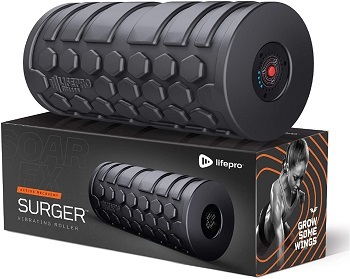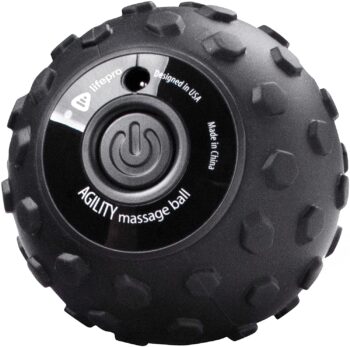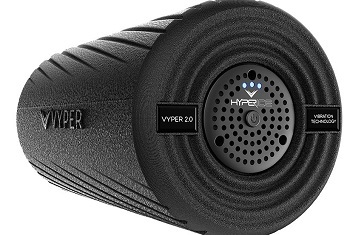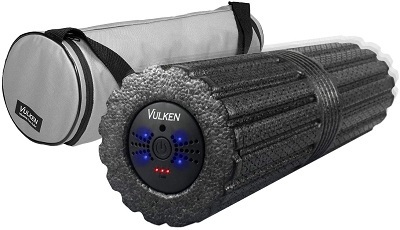The vibrating foam roller takes the traditional foam roller and the trigger point foam roller – to a whole new level.
Why?
High-frequency vibration massage softens the muscles faster, relaxes them, hinders pain signals, and allows for deeper trigger point kneading and releasing, leading to increased flexibility as well.
As some professional athletes say, it’s like a jackhammer breaking up the asphalt.
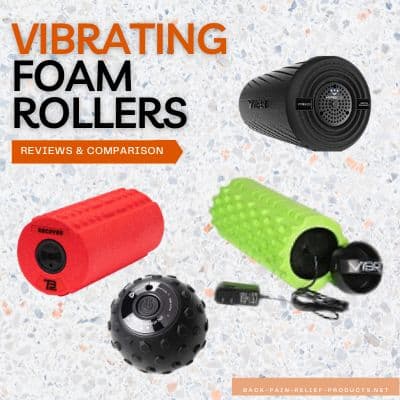
In this post, you’ll find the difference between vibrating foam rollers and regular ones, their benefits, how to choose, and the best vibrating foam rollers of 2025.
Overview
Are Vibrating Foam Rollers Worth It? (Pros & Cons)
Experts and researchers agree that vibrating foam rollers intensify the massage you get on your muscles.
The more intense the massage, the more oxygen, nutrients, and pain-relieving components arrive through your bloodstream to your painful or injured muscles.
Studies have shown that the added vibration feature makes foam rolling more than twice as effective as a regular foam roller.
Vibrating foam rollers can increase the range of motion, blood flow, and flexibility by up to 40%, compared to 18% with traditional foam rollers.
A vibrating roller is a great tool for post-workout soreness, muscle knots, and tension release, preventing DOMS, increasing blood flow and circulation, and healing injuries faster.
(You can also consider a massage gun for the most powerful trigger point massage)
On the other hand:
Vibrating foam rollers are generally more expensive than traditional foam rollers. They can be quite loud, and some people find that the vibration can be uncomfortable or even painful, especially if they have sensitive areas or injuries.
In a hurry? Here’s our short comparison table. Below you’ll find our full vibrating foam roller reviews and the pros and cons of each device.
This post may contain affiliate links, at no extra cost to you.
How to Choose a Vibrating Foam Roller for Back Pain
How do you choose a vibrating foam roller when you want to relieve back pain?
1. Length – For large areas (such as both sides of the spine from bottom to top) – consider choosing a longer vibrating roller.
For smaller areas, such as between the shoulder pain, you can go for a peanut roller.
2. Hardness – While most physical therapists recommend medium-density foam rollers (survey is here), vibrating foam rollers need to be hard so the vibration won’t dissipate and be less effective when you are on it.
3. Pattern – Some uneven patterns could help with basic myofascial release and trigger point release.
The delivery of vibration and intensity is more important.
The 4 Best Trigger Point Vibrating Foam Rollers
And now, here are our research results, after analyzing hundreds of consumer reviews:
1. LifePro Surger – Best for Exercise Recovery
- Size – 11.5″ long, 5.5″ diameter
- Weight – 3.9 lbs.
- Max intensity- 40 Hz
Pros – Lifetime money-back guarantee, 4 intensity settings, easy to use
Cons – Expensive
✅ $100 at LifePro / $89 on Amazon
The LifePro Surger foam roller with vibration was designed for athletes’ recovery after rough workouts and offers deep tissue and compression massage (for exercise recovery, including running, CrossFit, cardio, martial arts, etc.)
It has 4 intensity settings, and the charged battery lasts up to 2 hours.
It’s the only one on this list that offers a lifetime money-back guarantee!
The relatively low nodules feel firm and are best for muscle knot release and trigger point massage, to loosen up those aching muscles.
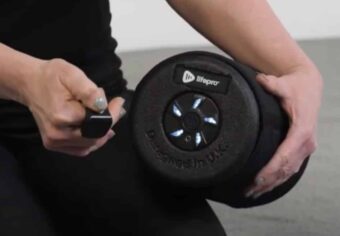
Pros
- Lifetime money-back guarantee
- A variety of speed intensities
- Easy-to-use single-button toggle controls
- Reliable customer service
Cons
- Length is shorter than average
✅ Available at LifePro ($100), and on Amazon ($89)
2. LifePro Massage Ball – Best for Muscle Knots
- Size – 4″ diameter
- Weight – 0.66 lbs.
- Max. Intensity – 60 Hz
Pros – Best for targeted trigger point release, compact, portable, high weight support, high intensity
Cons – Not fit for large muscle groups such as the lower back
✅ $50 at Life Pro
The LifePro unique and powerful little massage ball is specifically designed to release (and get peak performance) for smaller muscle groups and is an amazing pain-relieving tool for tight/sore muscles, hand/foot pain, sciatica, neuropathy, and fibromyalgia.
This small massage ball can support up to 220 pounds, and has 4 speed levels, with a maximum intensity of 60 Hz!
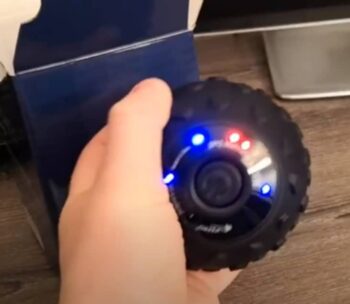
The LifePro massage ball is 100% portable, rechargeable, lightweight (0.66 lbs), compact (3.75 inches in diameter), and easy to take with you anywhere, including traveling overseas.
If you purchase on the official site, you get instant access to some excellent workout videos and instructions to help you achieve your goals, confusion-free and quickly.
✅ Available at Life Pro ($50), and on Amazon ($50)
3. Hyprice Vyper 2.0 – Highest Intensity
- Size – 11.5″ x 5.3″
- Weight – 3 lbs.
- Max. Intensity – 92 Hz
Pros – Highest intensity option on the market, smooth surface for beginners
Cons – Expensive
✅ $149 at Hyperice
The Hyprice new 2.0 vibrating roller has a more modest, ridged system that is best for beginners (with a low vibration setting) but the highest vibration intensity is quite powerful.
It has 3 intensity settings, and most users claim the medium setting is their sweet spot for relieving muscle pain in the lower and upper back, knee muscles, IT band, quads, and hamstrings.
This one is more suited for people with sciatica, arthritis, and back injuries who may feel too much pain using a highly rigid surface. On the other hand, it allows for a good massage for overweight people with muscles hidden behind some layers of fat tissue.
Pros
- Highly customizable massage speed settings
- Charges in as little as 20-30 minutes
- A smoother surface allows for a less painful massage, perfect for beginners
- Vibration is powerful enough to deliver a strong surface massage
Cons
- Not optimal for a trigger point release
- Somewhat noisy
✅ Available at Hyperice ($149)
4. Vulken Vibrating Foam Roller – Best Extra Long
- Size – 17″ long
- Weight – 2.1 lbs.
- Max. Intensity – up to 3800RPM
Pros – Best for large muscle groups (thighs, low back), 4 speed settings, pulsating mode, long battery life
Cons – Not for travel, too firm exterior for some users
✅ $80 on Amazon
If you are looking for a longer foam roller surface, you’ll like the Vulkan 17-inch foam roller with vibration, which gives you more space to roll out your shoulders, legs, and upper and lower back.
The 4 vibration settings include a pulsating mode you can use for blood circulation-boosting or muscle warming – without rolling at all.
The battery lasts for a couple of hours after charging, sometimes more, depending on the setting.
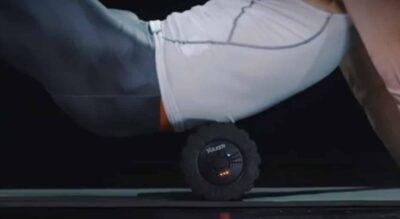
Pros
- Gentler than other rollers – good for painful muscle injuries
- Extra space to roll on
- Pulsating mode to gently warm up muscles before working out or physical work
- Made with an eco-friendly shell
- Long-lasting battery (more than 2 hours)
- Quietest electric roller
Cons
- Less compact, harder to transport (best for home use)
- The foam exterior is very firm
✅ Available on Amazon ($80)
How To Use a Vibrating Foam Roller for Back Pain
1. Start gradually and slowly – don’t be tempted to start with the highest intensity, especially if you suffer from medium-high pain levels. Start with the lowest setting for the first 2-3 sessions, until you get adjusted to the device.
2. Roll slowly for about 3 seconds for each movement. This is a slow process. Take 2-3 minutes for each muscle area.
3. Follow the long axis of the muscle and use downward pressure, focusing on large muscle areas such as the upper back, lower back, hamstrings, etc.
4. For trigger point release, do small and repetitive movements slowly.
5. For maximum results, consistency is key.
Try to foam roll every day for a few minutes to get the most out of this simple treatment.
Here’s a short video demonstration for the upper body:
Who Should Not Use a Vibrating Foam Roller?
Since this is an electrical vibrating device, some people should consult with their doctor before using it:
Pregnant women, diabetics, people with herniated discs, spondylitis, recent joint replacements, metal pins, pacemakers, and people who are recovering from surgeries.
Vibrating Foam Roller vs. Massage Gun
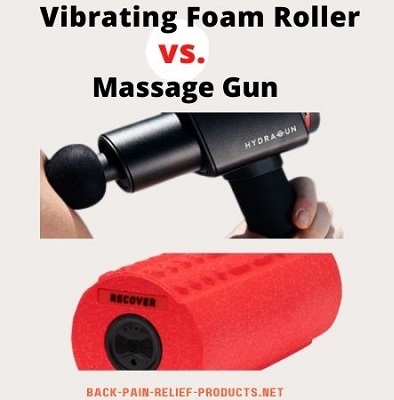
Massage guns deliver the same physiological benefits as vibrating foam rollers but in a different way.
While vibrating foam rollers deliver vibrating massage, massage guns apply high-speed percussion therapy – delivering quick bursts of pressure to a stiff and painful targeted area – to relieve trigger points and muscle soreness.
The main advantage of massage guns over a vibrating foam roller is the ability to target specific areas and the different massage heads that do this.
Also, Massage guns require less “work” because you can just hold them against a muscle, while vibrating foam rollers require lying down and adjusting yourself each time you want to change the treatment area.
Our favorite massage gun is the Hydragun, which is powerful enough for workout recovery, yet gentle enough to treat back pain from sciatica. See the list of massage gun pros and cons to help you decide.
To your health and happiness,
The Back Pain Relief Products Team
Studies
Imtiyaz S, Veqar Z, Shareef MY. To Compare the Effect of Vibration Therapy and Massage in Prevention of Delayed Onset Muscle Soreness (DOMS). J Clin Diagn Res. 2014;8(1):133‐136. doi:10.7860/JCDR/2014/7294.3971
